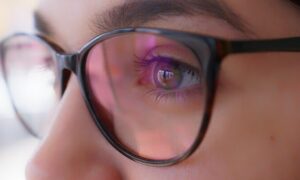Astigmatism, a common refractive error affecting vision, has always raised many questions. In this article, we’ll explore its causes, symptoms, and various correction options available to individuals seeking clearer vision – and also explore whether glasses can help astigmatism.
Understanding Astigmatism
Astigmatism is a refractive error that occurs when the cornea or lens of the eye has an irregular shape, causing light rays to focus unevenly. This results in blurred or distorted vision, making it challenging to see both near and far objects clearly. Unlike myopia (near-sightedness) or hyperopia (farsightedness), astigmatism often involves a combination of these visual impairments.
Causes and Symptoms
Astigmatism can be congenital or develop over time due to factors such as eye injury, surgery, or changes in the cornea’s shape. Individuals with astigmatism may experience symptoms like blurry or distorted vision, eye strain, headaches, and difficulty seeing in low-light conditions. Regular eye examinations are crucial for detecting astigmatism and ensuring timely correction.
Correction Options
- Prescription Glasses: Prescription glasses are a common and effective solution for correcting astigmatism. Specially designed lenses, known as toric lenses, compensate for the irregular curvature of the cornea or lens, allowing light to focus properly on the retina. Glasses are a convenient option for those who prefer not to wear contact lenses or undergo surgery.
- Contact Lenses: Toric contact lenses are another popular choice for astigmatism correction. These lenses are designed to align with the irregular shape of the cornea, providing clear vision without the need for glasses. While some individuals find contacts more comfortable for certain activities, others may prefer the simplicity of eyeglasses.
- Refractive Surgery: For those seeking a more permanent solution, refractive surgery options such as LASIK or PRK can correct astigmatism by reshaping the cornea. While surgery may not be suitable for everyone, advancements in technology have made these procedures safer and more precise, offering long-term visual freedom to many individuals.
- Orthokeratology: Orthokeratology involves the use of specially designed contact lenses that are worn overnight to reshape the cornea temporarily. This non-surgical option can provide clear vision during the day without the need for glasses or daytime contact lenses, offering a reversible alternative for some individuals.
Astigmatism is a common vision condition that can be effectively corrected through various options, ranging from prescription glasses and contact lenses to refractive surgery and innovative alternatives like orthokeratology. Understanding the causes and symptoms of astigmatism, coupled with regular eye examinations, empowers individuals to make informed decisions about the most suitable correction method for their unique needs. Whether opting for the convenience of glasses, the flexibility of contact lenses, or the long-term benefits of refractive surgery, clear vision is within reach for those navigating the complexities of astigmatism.



































